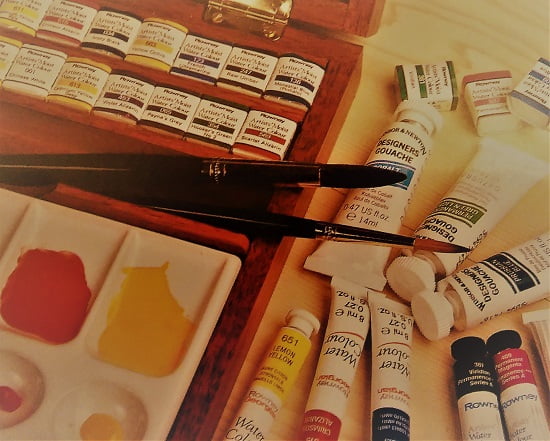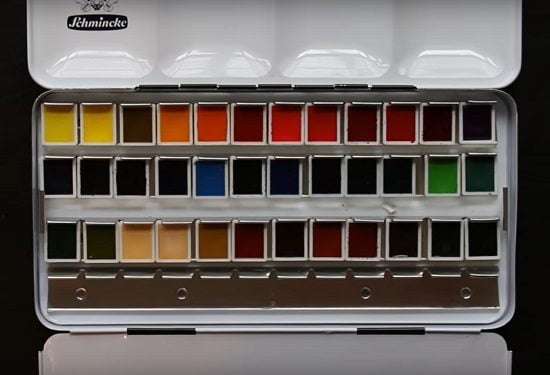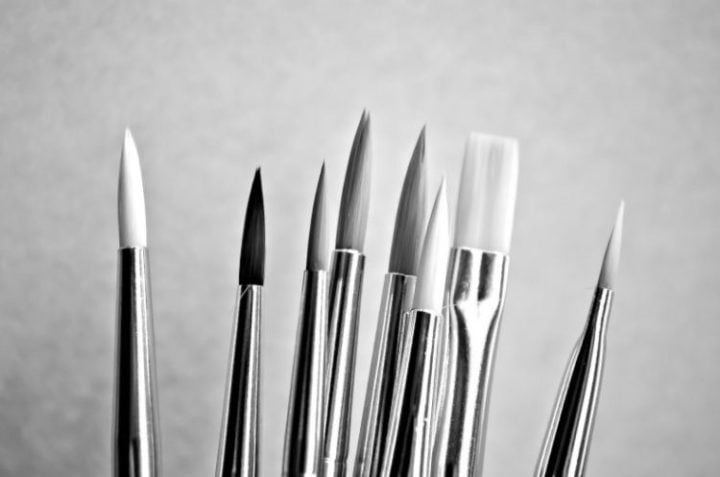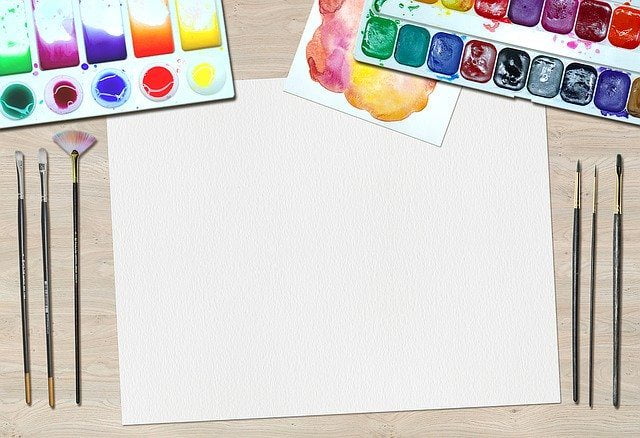One of the advantages of watercolor painting is that you do not need a lot of supplies to be able to do it. All you need is a few paintbrushes, paints and paper and you are ready to paint. Tools for watercolor painting are also much cheaper than those for oil painting which makes watercolors an ideal choice of technique for beginners.
Watercolors
Watercolors consist of fine grind pigment mixed with gum arabica and a wetting agent. There are two different types of watercolors and those are student grade watercolors and professional watercolors. Student grade watercolors are cheaper but you will get much better results using professional grade paints since they have pigments of better quality.
Student grade watercolors are always of a similar almost same price but when it comes to professional watercolors price can be very different depending on the pigments used to produce the specific color.
Watercolors are usually sold in pans, half pans and tubes. Paint in the tubes is wet and goes from almost liquid to a creamy consistency it is good for coloring large areas quickly. The paint in the pans is semi-wet it can be bought in special color sets or individually.
Pans are affordable and very convenient to carry for painting outdoors. However, it cant be used for coloring large areas quickly since you can’t take a big amount of paint on the brush.
Paintbrushes
The most common mistake all beginners make when purchasing watercolor paintbrushes for the first time is that they chose too small brushes. Since small brushes can only be used for fine details their use is very limited. It is much better purchasing bigger brush of better quality than a few little brushes since it can be used for large spreads of paint as well as for fine details.
When it comes to choosing watercolor brush it is much better buying the most expensive you can afford. Better brush means better work and it lasts much longer so basically cheap brushes don’t save you money since you have to purchase them more often.
Sable bristle brushes are the best choice for watercolor painting. They are a bit more expensive but it is a real delight working with those. If you clean them properly they will last you very long. Sable hair is elastic, long-lasting and it naturally shrinks into a narrow point after washing.
Synthetic brushes are a popular replacement for sable brushes since they are much cheaper and still elastic and a lot alike sable brushes. But, synthetic brushes cant hold paint as well as natural ones and they do not last long. You can also purchase brushes of mixed sable and synthetic bristles.
Proper cleaning of the brushes is very important if you want them to last you for a long time and it is also very simple. All you need to be careful about is never to leave your brushes in the water since it damages the bristles and the brush handle as well.
After you finish painting simply rinse off all the paint of your brush with running water making sure there are no paint residues near the ferrule since dried paint can deform the shape of your brush and make it unusable.
After you washed it properly shape the bristles into a fine point and leave it to dry making sure the bristles are facing up. Make sure the brushes are perfectly dry before you put them back in a box.
Shapes Of Brushes
Basic shapes of watercolor brushes are round and flat. Round brushes are dome-shaped with a pointed tip. If you paint with the side of the brush you get wide lines while using the tip you can paint fine details. Flat brushes are ideal for adding water to the paper and the edge of the flat brush can be used for sharp lines.
Sizes Of Brushes
Sizes of the brushes go from 0000 up to 24. Size of the flat brush is usually the width of the brush in mm. The sizes are not standardized so they do not have to mean that the brushes will be the same size if they carry the same markings it all depends on the manufacturer and also natural bristle brushes are mostly hand made so the size can vary even with the same manufacturer.
Watercolor Paper
There are many different kinds of aquarelle paper on the market. They differ in texture, weight and quality. Which one to chose depends mainly on your painting technique and how much are you ready to spend for it. Start with buying single sheets of different watercolor paper. That’s the easiest way to realize which one suits you best.
Watercolor paper can be handmade or manufactured in a factory. The difference shows mostly in the prices. Plane natron paper is good for drawing but in no way good for watercolors since it deforms after being moist and it doesn’t have a good texture.
Best handmade paper is made of cotton rags instead cellulose from wood. It’s usually recognisable buy uneven edges and the watermark of the manufacturer in the corner. Paper made in moulds is of very similar quality as handmade paper but much cheaper. There is also a factory-made paper which is the cheapest but the structure of it is very mechanical.
You can purchase watercolor paper in sheets or in rolls which are cheaper than sheets. Most of the watercolor papers are white or yellowish in order for the whiteness to reflect the light through transparent layers of paint.
Texture Of Watercolor Paper
The surface texture of the paper is called paper grains or teeth. There are three different kinds of surfaces. A hot-pressed paper which is almost completely smooth that is good for very detailed work.
The cold-pressed paper has semi granulated texture which is good for bold brushstrokes as well as for fine details. This kind of paper is the most suitable one for beginners.
The rough heavily granulated paper makes the paint disperse and sink into the surface leaving tiny white grains that make color spreads look bright.
Weight of the paper is usually measured in grams per square meter. The lightest watercolor paper weighs 150 g/m2 while the heaviest is 640 g/m2. The lighter paper has to be previously prepared for painting since it can bend when you ad paints to it if its not stretched and prepared.
Palettes
Watercolor palettes are made in various shapes and size out of materials like plastic, ceramics or metal. They are always white which helps you determine the right nuance of the paint you put on them. You can also use improvized palettes such as bowls, small plates, jars, cups as long as they are white and not transparent.
Additional Supplies
There are gelatines you can mix with watercolors to make them thicker and shinier. If you used them carefully they will help you get a strain of various effects on your painting that you can not get using only watercolors.
There is gum arabica that gives better transparency and shine to watercolors, aquapasto transparent gelatine that adds to the thickness of the paint to gain an impasto effect and ox gall solution.
You will also need well sharpened drawing pencil, kneaded eraser, a soft rag to remove redundant paint natural sponge for adding rougher surfaces of paint, jars for water, wooden drawing board, rubber ducktape to secure the watercolor paper to the board and art masking fluid to temporarily cover the surfaces on the paper that you do not wish to paint on.
Now that you have all of your supplies ready nothing is stopping you to start painting. If you have any questions I will be happy to answer them just leave them in comment section.








0 Comments